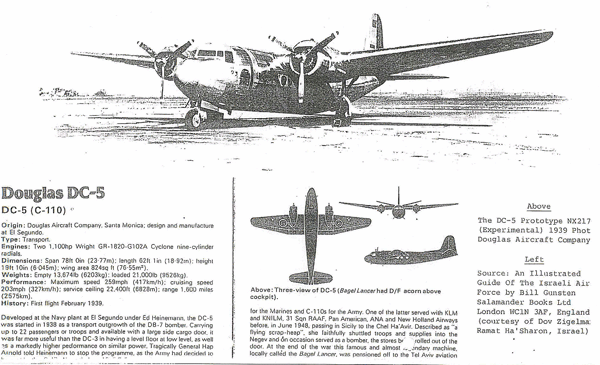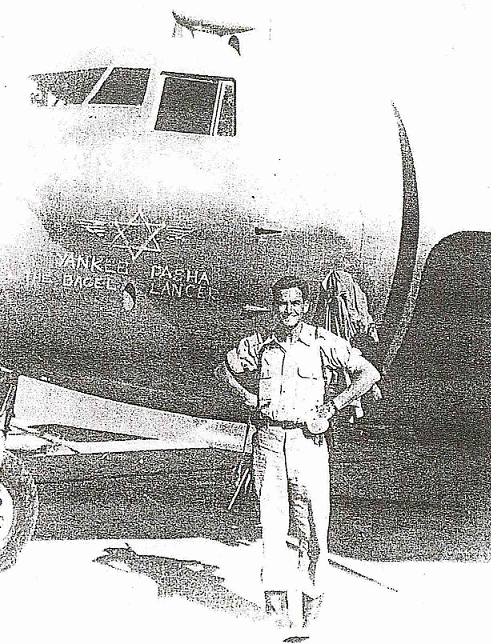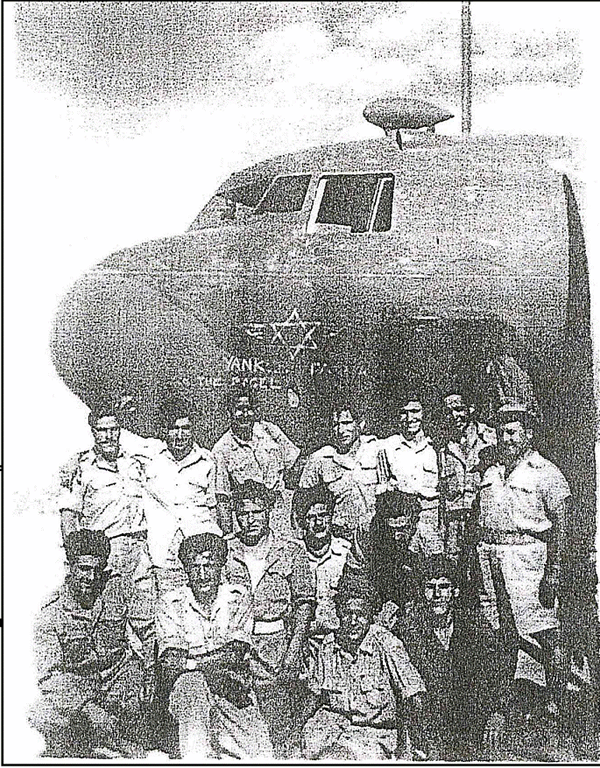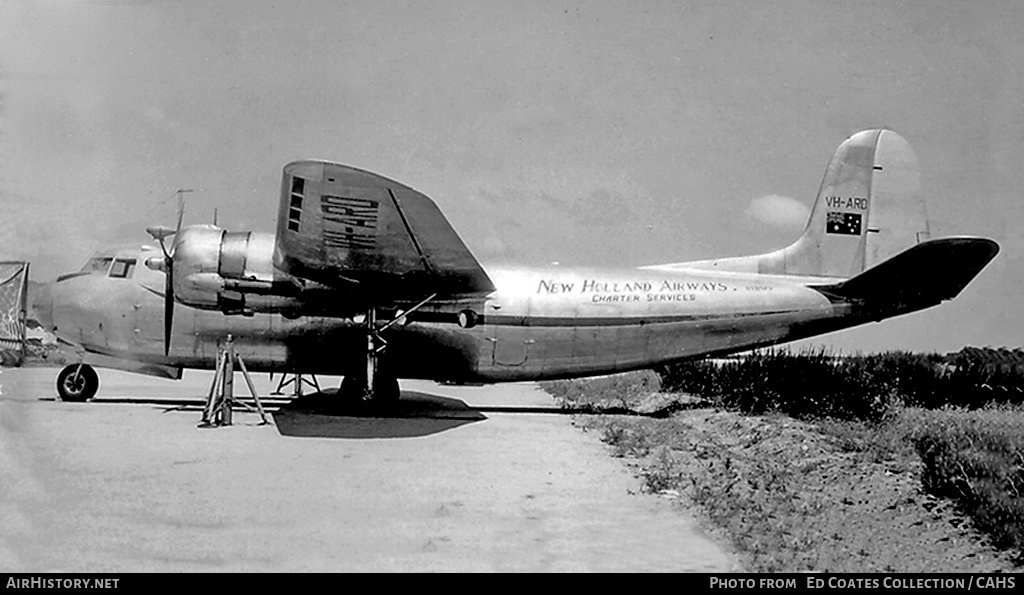THE LAST FLIGHT OF THE LAST DC-5:
EDITOR’s NOTE (November 2021) : With thanks to Lawrence Ribakoff for this updated information and photo of the DC-5 at Haifa, Israel after delivery by Hal Auerbach. Scroll down.
AN ALMOST FORGOTTEN DOUGLAS AIRLINER IS REMEMBERED –
A DEFERRED OBITUARY FOR “YANKEE PASHA, THE BAGEL LANCER”
In June 1948 the State of Israel – then a month old and under attack by six invading armies – was an unlikely place to meet an old friend from California whom I hadn’t seen in almost a decade. There, at the Tel Aviv airport‚ was a Douglas DC-5, a rare twin-engine commercial airliner. It was one of a total of 12 built by the Douglas Aircraft Company in 1939-41 when I was a Douglas employee.What was a DC-5 doing in the middle of an Arab-Israeli war? On May 15th 1948 Great Britain pulled out of Palestine which it had governed for 30 years under a League of Nations mandate. On the same date the State of Israel was born, and its baptism of fire to exist as a nation formally began.
With only a few small training airplanes for defense, Israel was desperate to acquire anything that could fly. Word went out to the aviation world that anyone who wanted to unload a used airplane and could fly it, could sell it to Israel. In Sicily a DC-5 was offered for sale. Although no one in Israel knew much about a DC-5, Danny Agronsky, Israel Air Force’s man in Italy, was authorized to buy it immediately.
The airplane landed in Tel Aviv looking war weary in World War II camouflage, obviously needing maintenance, but still flyable. Originally it had been a 16-passenger commercial airliner but all upholstery and seating had been removed, leaving a bare cargo interior. The letters VH-ARR on its wings identified it as an Australian aircraft. But the original owner’s name Koninllijke Nederlandsch-Indische Luchtvaart Maatschappi (KLM Dutch East Indies Airlines) was still visible under its camouflage paint.
In 1939-41 the Douglas El Segundo Division built 12 DC-5s – a prototype, four luxurious 16-passenger airliners all for the KLM Dutch East Indies Airlines, and seven R3-D military cargo versions for the U.S. Navy. Designed by Douglas Chief Engineer Ed Heinemann, the DC-5 was an airline adaption of the swift A-20 and DB-7 attack bombers that Douglas built for the U.S. Army and the French air forces. The airline version was a fast, short-range, state-of-the-art sister ship of the world renowned 21-passenger DC-3 and Douglas’s new four-engine DC-4 Skymaster. When World War II began, the El Segundo plant converted to the manufacture of A-20s and other warplanes. After the 12th DC-5 was built, production ceased and was never resumed.
According to a Skyways Magazine historian, one of the four KLM DC-5s was captured when the Japanese overran Indonesia in World War II; the other three escaped to Australia, two of which were later cannibalized for parts. All other DC-5s either didn’t survive the war or were scrapped shortly afterwards. Later we learned that the DC-5 Israel bought in 1948 was the last of the breed still alive.
From my years as a Douglas employee I retained a nostalgic feeling for the DC-5, but also a memory of tragedy. Although I never flew one, I was determined to fly the DC-5 that arrived in Tel Aviv.
I first became acquainted with the DC-5 when I was a Douglas Aircraft Company employee and visited the Douglas El Segundo plant in 1940. After graduating from UCLA in 1938 I was happy to get an entry-level job at Douglas as a typist and parts chaser (expediter) in the Experimental Planning Department of the Santa Monica plant.
The pay was 25 cents an hour, but for a newcomer like me, fascinated with airplanes, the adventure of working in a department where secret new aircraft were developed was like being Alice in Wonderland. At that time one of the planes our department was building was the world’s biggest airplane – the XB-19 experimental prototype intercontinental bomber. It had a wingspan the length of a football field!
Several months later, I was employed in the Export Sales Department, and ran some parts and drawings to the El Segundo Division where DC-5 airliners for KLM Dutch East Indies Airline were being built. In some small way I felt identified with the origin of this airplane, but never dreamed that I, a parts chaser, would some day become a DC-5 pilot. Nor did I foresee being an eyewitness to the fatal crash of a DC-5 a few months later.

In 1940, while employed at Douglas, I was also a weekend student pilot learning to fly at California Flyers, a civilian flight school based at a small country airfield named Mines Field. About 12 miles southeast of Santa Monica, the airfield was bounded by Hollywood Redondo Highway (now Interstate 405) on the east and Sepulveda Boulevard on the west. It had one runway and a large unpaved grass area which had been a lima bean farm a few years before. Wearing helmet and goggles and learning to fly in an open cockpit biplane, I made my first solo flight from that old bean field. Years later Mines Field and the surrounding lima bean farms expanded to what is now known as LAX – Los Angeles International Airport.
On a bright June morning in 1940, a new DC-5 taxied out for its initial flight from the Douglas plant adjacent to Mines Field. We students stood alongside the runway admiring the graceful lines of this airplane. Innovative in design, the DC-5 was the first airliner with tricycle landing gear and nose wheel. Factory fresh, gleaming and sparkling in the bright California sun, her engines revving for take-off, she was a beautiful creation to behold.
Starting her climb, maybe 150 feet in the air, her left wing surprisingly dipped. We stood astonished as the dip grew into a kind of slow roll To our horror, the roll continued until, almost inverted, she crashed and exploded in a fireball not far off the end of the runway. We ran as close as we could to the scene. All aboard were killed, their bodies charred and scattered in the burning wreckage.
Why? We all wondered. Being a Navy DC-5, possible sabotage or any other explanation was kept secret. But rumors spread around the factory that the aileron cables were reversed in manufacture, and no one in final assembly or pre-flight inspection detected the impending tragedy. But assuming that, why didn’t experienced Douglas test pilots visibly check for correct aileron movement when first entering the cockpit, one of the first things we student pilots were taught. Why?
I never learned the official explanation because in December of 1940 I left Douglas to enter the U.S. Navy as an aviation cadet. I reported to the Navy at Long Beach Municipal Airport for primary training, then on to Pensacola, Florida, where we earned our wings. During most of the war, I flew PBY Catalina twin-engine flying boats based at Pearl Harbor and Australia.
In early 1948 I was one of about 150 airmen – mostly Jews, but Christians, too – who volunteered to go to Palestine to help fight for Israel’s birth and survival. We were former World War II aircrew who flew in the U.S. Army, Navy, Marines, Canadian, British, and other Air Forces. When the war ended, after five years of military flying, I left the Navy as a Lieutenant Commander and was a well-trained, experienced pilot.
The odyssey that led me to the DC-5 in Israel began in March 1948 at Burbank, California. There I transitioned from PBYs to C-46 Curtiss Commandos, the Army’s biggest twin engine cargo plane at that time. With money from the Jewish Agency for Palestine, a Panamanian airline named Lineas Aereas de Panama Sociedad Anonomia (LAPSA) was created. 12 almost-new war surplus C-46s were purchased for about $10,000 each. With the Panama flag flying on our tail, we flew in stages to Mexico, Panama, Dutch Guiana, Brazil, across the South Atlantic to Africa, north to Morocco, Sicily, and through the Iron Curtain to a pre-arranged base in Czechoslovakia.
Without international clearances or flight plans, LAPSA became an underground airline secretly flying arms and ammunition from Europe to Israel. From a former Nazi airstrip in the Sudetenland west of Prague we flew disassembled Avia S-199 (the Czechoslovakian version of the German Messerschmitt ME-109 fighter planes) inside out big C-46s to Israel. There, Jewish and Christian volunteers who had World War II fighter plane experience flew the reassembled ME-109s in combat.
In June 1948, half a world away from California at the Tel Aviv airport, I got ready to fly the DC-5 that flew in from Italy. The trauma of watching her sister ship crash at Mines Field eight years earlier still lingered in my mind. But sitting in the cockpit of a DC-5 for the first time in my life, I believed I understood why her sister ship had crashed.
Because of the DC-5’s high wing design and engines mounted below, its ailerons could not be seen from the cockpit. Assuming that a new airplane passing final factory inspection must have had properly working controls, the Douglas test pilots, I concluded, were not aware of the impending death roll awaiting them at Mines Field in 1940.
To make sure that Israel’s DC-5 would not involuntarily roll on its back, I called out of the cockpit window for someone on the ground to confirm correct response as I rolled the ailerons up and down. Finding them OK, I then familiarized myself with the controls, instruments, and emergency systems. Confident I could handle the DC-5 without transition training, we lined up on the runway for take-off, pushed the throttles all the way home, and headed out over the Mediterranean.
In flight the DC-5 was a stable and gentle airplane with no bad habits, fast, responsive and easy to fly. After a few practice take-offs and landings, I taxied back to the ramp with the heady feeling that I – once a 25 cents an hour parts chaser at Douglas – had flown one of the DC-5s I had chased parts for. For me it was a triumphant reunion with an old friend.

“Yankee Pasha” pilot Hal Auerbach (Hillel Bahir) with the DC-5 in Israel
I promised myself I would be back to fly the DC-5 again as soon as I returned from an upcoming C-46 flight to Czechoslovakia. But my reunion with the DC-5 in Israel almost didn’t happen.
A week later, on a bright sunny morning flying southbound from Czechoslovakia to Israel with a disassembled Avia S-199 fighter plane inside our C-46, we flew over the snowcapped Alps at 16,000 feet and entered Italian airspace.
Waiting for us up there was an Italian Air Force fighter plane. Moving into formation 20 feet off our wing, the fighter pilot signaled by hand and landing gear that we were to follow him down and land. With no cloud cover to hide in, and persuaded by four nasty looking machine guns bristling from his wings, we accepted his invitation. He forced us down to the Italian Air Force base at Treviso, about ten miles north of Venice, where he made sure we landed.
The Commandante at Treviso informed us we were under arrest for smuggling arms and ammunition to communist insurgents inside Italy. At that stage of the Cold War, he made us aware that the Italian and American governments were seriously concerned with internal sabotage or the possible overthrow of Italy by Soviet surrogates. He interrogated us off and on for about four hours in pretty good English, but spoke strangely, with a southern accent. He was also suspicious why, flying a Panama-licensed airplane ostensibly en route to Casablanca in Morocco, we should want permission to phone the Israeli Embassy in Rome. Finally he permitted us to do so. Two hours later, his Air Force superiors phoned from Rome that we were on innocent passage to Israel, were not smuggling arms into Italy, we were no threat to the Italian government, and we should be permitted to leave.
Our relationship with the Commandante then became warm and cordial. A pilot himself, we all enjoyed airman-to-airman camaraderie. He put us up in a hotel overnight and picked us up in his command car the next morning. At our request he drove us to the wholesale food market. We purchased almost a ton of food unobtainable in Israel or Czechoslovakia – whole sides of beef, cases of butter and eggs, bags of sugar and flour, and fresh and canned goods – which we loaded into the C-46 alongside the Avia S-199. He had our plane refueled, and gave us some autopilot parts we needed. We reciprocated with cartons of American cigarettes.
Before leaving we asked the Commandante how come he spoke English with a southern accent. He replied that he had been interned in an American prisoner-of-war camp in Mississippi and learned English by listening to local radio all day long for two years.
In mid-July, back from Treviso, we found that Israel, then two months old, was hanging onto its life by a toehold. Arab forces had almost cut the pint-size new nation in half at a pinch point where it was eleven miles wide. There, from mountain-top positions, Arab artillery was pounding the Haifa-Tel Aviv road, Israel’s only north-south lifeline which held the country together.
Looking for some useful mission that would justify flying the DC-5, I met with Ray Kurtz, the self-styled Nose Commander of three B-17 Model BAB four-engine Flying Fortresses. A week before, these aircraft flew to Israel from Czechoslovakia, bombing Cairo’s main airfield en route. In an earlier life, they were mighty B-17s flown by the U.S. Army Air Forces in World War II. After the war, stripped of all military equipment, they were sold as war surplus by the U.S. government. Licensed as air freighters and flown to Czechoslovakia, they were refitted with armament salvaged from German, British, and American Air Force dumps. Hence they become B-17 BABs, Born-Again-Bombers.
Ray received orders for the B-17 BABs to bomb the gun positions shelling the Haifa-Tel Aviv road. In those desperate weeks even transport aircraft were used as bombers, with aircrew chucking 50-kilo bombs out of the open back door. I asked Ray if he’d mind if the DC-5 joined up as a backdoor bomber flying inside his three- plane formation. He said OK, he would arrange for bombs and bomb-chuckers for us. Bomb-chuckers were mostly immigrant soldiers who knew no English but hopefully comprehended enough sign language to heave live bombs out the back door without exploding them inside the airplane.
In World War II, flight crews often gave their aircraft colorful names. In that tradition, and to add a little schmaltz to an otherwise tense mission, we named the DC-5 Yankee Pasha, The Bagel Lancer.
Flying the DC-5, we rendezvoused with the B-17 BABs at their assigned altitude, and elbowed our way into the middle of their formation. Because we were encircled with B-17 defensive firepower, we felt pretty safe. We knew we were more at risk from bombs exploding inside our airspace than from enemy gunfire. As soon as we saw the B-17s open their bomb bay doors and release their bombs, we chucked ours out the back door. Our co-pilot Bob Luery, also a volunteer Californian, took what must the world’s only photo of a DC-5 Back-Door-Bomber taking part in a B-17 bombing run.
On landing in Tel Aviv, Yankee Pasha’s brakes failed and she kept rolling towards the end of the runway. Fortunately, we were able to steer her into a low sand dune alongside the runway, where her wheels plowed into a safe, gentle stop.
The mission completed successfully, I kissed that DC-5 goodbye, took a last sentimental look back at her sitting deep in the sand, went back to my C-46s, and that was the last I ever saw of her.

“Yankee Pasha the Bagel Lancer,” the world’s last DC-5 alive at the time, sits for her final portrait with the armorers and bomb-chuckers who flew with her on her final flight. Ramat David, Israel, July 21th 1948
Forty-five years later, in May 1933, at a reunion in Tel Aviv of volunteers who helped defend Israel in 1948, I learned that Yankee Pasha never flew again. Due to lack of spare parts and other logistical reasons, she remained grounded after our backdoor bombing flight. Finally, her wings removed, she was trucked to the Technion in Haifa for training engineers and maintenance mechanics. Where she went after that, no one seemed to know. No record was available of her final disposition, but several peers from the 1948 Israel Air Force thought it was likely that she was sold for scrap.
For aviation historians, this narrative is a requiem for the last of the Douglas DC-5s, and the closing chapter in the Book of Life of this rare, almost forgotten type of airliner. For me, this narrative is a deferred obituary for an old friend whose origins I shared and words of fond remembrance of the historic time and place we last flew together.
In a sense, more than half a century ago, we were both products of the Douglas Aircraft Company. This DC-5’s years of flying and my years as an active aviator both began from the same runway at Mines Field in California – both ended half a world away flying together in the skies over Israel.
If that DC-5 was scrapped, I like to believe that in the Biblical Land of Israel where resurrection can happen, Yankee Pasha the Bagel Lancer rose from her grave in the scrap heap and lives on today in the Holy Land as thousands of hallowed aluminum fry pans!
Now, half a century later at age 81, I say goodbye to an old friend.
Farewell DC-5, Shalom Yankee Pasha
Source: Hal Auerbach, a semi-retired financial consultant living in Carmel, California, November 1998. At the time of writing, he flies only an LF-5D – a Large Flat Desk with Five Drawers.
EDITOR’s NOTE (November 2021) : With thanks to Lawrence Ribakoff for this update including Photo of DC-5 at Haifa, Israel after delivery by Hal Auerbach.
With reference to A Memoir by Hal Auerbach (Hillel Bahir) concerning the DC-5 “Bali Clipper” or Yankee Pasha/Bagel Lancer, I make note concerning its history. The subject DC-5 was registered VH-ARD to a Greg R Board and G.W. Hanlon in 27 April 1948 (New Holland Airways) and was named Bali Clipper. It was illegally sold, without Australian approval, to Machal/Mahal MARTIN ALLEN RYBAKOFF (formally RIBAKOFF) Catania, Sicily 28 May 1948. Source: www.spiritsofansett.com


